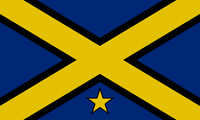Ædhige: Difference between revisions
(Linguifex wiki on Ædhige) |
No edit summary |
||
| Line 2: | Line 2: | ||
|name=Ædhige | |name=Ædhige | ||
|pronunciation=/ˈæːðɪgə/ | |pronunciation=/ˈæːðɪgə/ | ||
|states=The | |states=The Ædan Islands, natively Ædanir ('the islands') | ||
|region= | |region=Ædan Mhur, Ædan Mhic, Læchem, Ædan Lhua, and several other inhabited islands | ||
|speakers= | |speakers=around 1,200,000 | ||
|date=2017 | |||
|familycolor=Indo-European | |familycolor=Indo-European | ||
|fam2=[[Celtic languages|Celtic]] | |fam2=[[Celtic languages|Celtic]] | ||
| Line 10: | Line 11: | ||
|ancestor = [[Old Ædhige]] | |ancestor = [[Old Ædhige]] | ||
|ancestor2 = [[Middle Ædhige]] | |ancestor2 = [[Middle Ædhige]] | ||
|image=Aedanir_flag.png | |||
}} | }} | ||
| Line 23: | Line 25: | ||
==Introduction== | ==Introduction== | ||
<p><b>Ædhige</b> is a Celtic language of the Indo-European language family originating on the Ædan Islands in the North Atlantic Ocean. It is spoken by the Ædhici, a group of around | <p><b>Ædhige</b> is a Celtic language of the Indo-European language family originating on the Ædan Islands in the North Atlantic Ocean. It is spoken by the Ædhici, a group of around 1.2 million people. The majority live on the four biggest islands: <b>Ædan Mhur</b> ('<i>big island</i>'), <b>Ædan Mhic</b> ('<i>little island</i>'), <b>Læchem</b> (from the Old Ædhige for 'mines by the lake'), and <b>Ædan Lhua</b> ('<i>sun island</i>'), although the archipelago has another 10 smaller inhabited islands, all with populations of under 50 people.</p><p> The language can trace its roots to Proto-Celtic but due to the isolated location of the archipelago from the rest of Europe, Ædhige became a distinct language in the first century CE. Over the centuries the language has been influenced by other Celtic languages - namely Irish due to its proximity to the islands; and Germanic languages - namely Old Norse and English.</p> | ||
<!-- Design goals, inspiration, ideas, who speaks it?, when was it created?, where does it come from?, any peculiarities? --> | <!-- Design goals, inspiration, ideas, who speaks it?, when was it created?, where does it come from?, any peculiarities? --> | ||
Revision as of 21:16, 22 July 2017
| Ædhige | |
|---|---|
 | |
| Pronunciation | [/ˈæːðɪgə/] |
| Created by | – |
| Native to | The Ædan Islands, natively Ædanir ('the islands') |
| Native speakers | around 1,200,000 (2017) |
Early forms | |
Introduction
Ædhige is a Celtic language of the Indo-European language family originating on the Ædan Islands in the North Atlantic Ocean. It is spoken by the Ædhici, a group of around 1.2 million people. The majority live on the four biggest islands: Ædan Mhur ('big island'), Ædan Mhic ('little island'), Læchem (from the Old Ædhige for 'mines by the lake'), and Ædan Lhua ('sun island'), although the archipelago has another 10 smaller inhabited islands, all with populations of under 50 people.
The language can trace its roots to Proto-Celtic but due to the isolated location of the archipelago from the rest of Europe, Ædhige became a distinct language in the first century CE. Over the centuries the language has been influenced by other Celtic languages - namely Irish due to its proximity to the islands; and Germanic languages - namely Old Norse and English.